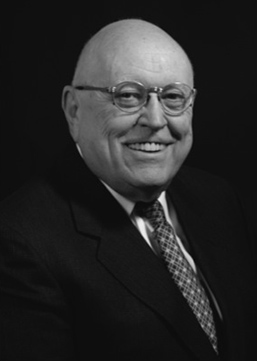
Harry Sweeney’s many contributions to the healthcare advertising profession span the gamut from exceptional creative talent to business leader/manager, from mentor to industry advocate. In addition to creating memorable campaigns for major products, he has made significant contributions to numerous organizations and the careers of individuals who worked for and with him. However, when you speak with his peers and those he mentored, it is clear that they recognize him as the consummate writer. We all know lawyers who fancy themselves as copywriters, but how many copywriters are there with a law degree? Harry Sweeney fills the bill. He received his doctorate from New York University School of Law in 1966, giving him another perspective on advertising and communications.
Harry’s involvement with healthcare began in 1957 with his military service. He was assigned to the Walter Reed Army Institute of Research. After two years of service, he entered the industry as medical copywriter for Lederle Laboratories, working for Austin Daly and old-school copy supervisor David Piper.
While at Lederle, Harry worked with a team of individuals that were to become major forces in the industry – Bob Devanna (later ad director at Roche), Bob Oppenheimer, and market researcher John Aherne. Ten months into his stay at Lederle he transferred to field sales as a regional trainee. After his introduction to the industry at Lederle, Harry moved to ER Squibb. Advertising Director Norman Sprei recognized his creative talent, and told him that he should look to a career with an advertising agency that could best utilize it. This lead to a move to Sudler & Hennessey where he first met future partner and Hall of Famer Dick Jones, who worked for the legendary Herb Lubalin.
After S&H, Harry joined L.W. Frohlich, where he became copy supervisor on the Mead Johnson account, despite being the youngest writer on the staff. Mead Johnson was one of the agency’s most important clients, and Harry proved his mettle with a series of successful campaigns for them. Harry left Frohlich to join the Paul Klemtner agency, which was a shop on the rise, and home to such talents as Bob Buchert, Clive Lewis, Morgan Cline, Frank Hughes, Tom Domanico, Charlie Daly, and Paul Chusid. At Klemtner, Harry created an exceptional campaign for Ayerst’s Premarin, using an image of a good looking middle-aged woman with the headline “Help Keep Her This Way.” Ayerst’s notoriously demanding advertising director Whit Jensen approved the ad without changing a word, and it ran for an unheard of three years with no copy changes.
Shortly after that, Harry got his initiation in to management when he was named head of the copy department, a position he held until moving to another “hot shop,” Shaller Rubin. At Shaller Rubin, Harry handled both Rx and OTC brands, which required a different style of advertising. During his stay, he worked on both Eaton’s OTC Chloraseptic, and Endo’s Rx Percodan.
In 1971, Harry went out on his own, acquiring the Dorland Agency. Together with his wife Rita and a highly motivated staff, he built Dorland into a leading specialized healthcare agency. Premarin and Tagamet are among the memorable campaigns he created for Wyeth and SKF, respectively. The agency’s list of “firsts” is impressive. In addition to Premarin and Tagamet, both “firsts” in their fields, the agency handled the first cholesterol drug (Atromid-S) and the first sequential oral contraceptive. Other major accounts included Syntex, Merck, Lederle, Roche Diagnostics, and Chiron. The agency also handled numerous accounts in the vision and diagnostic & testing fields, plus international accounts. In addition to drug companies, Dorland’s clients have also included service organizations such as the AMA, IMS, and Medical Economics, as well as numerous public service campaigns.
In addition to recording a long record of firsts for his agency, being a born organizer and forceful leader, Harry understands the need to nurture the common interests of agencies devoted to healthcare marketing. This led him to support Pat Dugan in forming the Medical Advertising Agency Association, which later became a section of the 4As. He also played a key role in the founding of the Coalition for Healthcare Communication, and the Medical Advertising Hall of Fame.
Harry has always been a strong advocate for the industry. In addition to his role with the MAAA, 4As, Coalition, and MAHF, he has devoted time and effort to numerous other industry groups. He served on the boards of the American Medical Writers Association, the Art Institute of Philadelphia, and the HMCC, which chose him as president in 2001.
If Harry Sweeney’s career were to be measured only as a writer, he is one of the industry’s elite. His accomplishments in managing and building a successful business in an environment of corporate behemoths mark him as an outstanding leader. His contributions to the industry are too numerous to list. When all are taken together, he stands out as one of the industry’s most notable performers, a genuinely rare individual who deserves to take his place as a member of the Medical Advertising Hall of Fame.